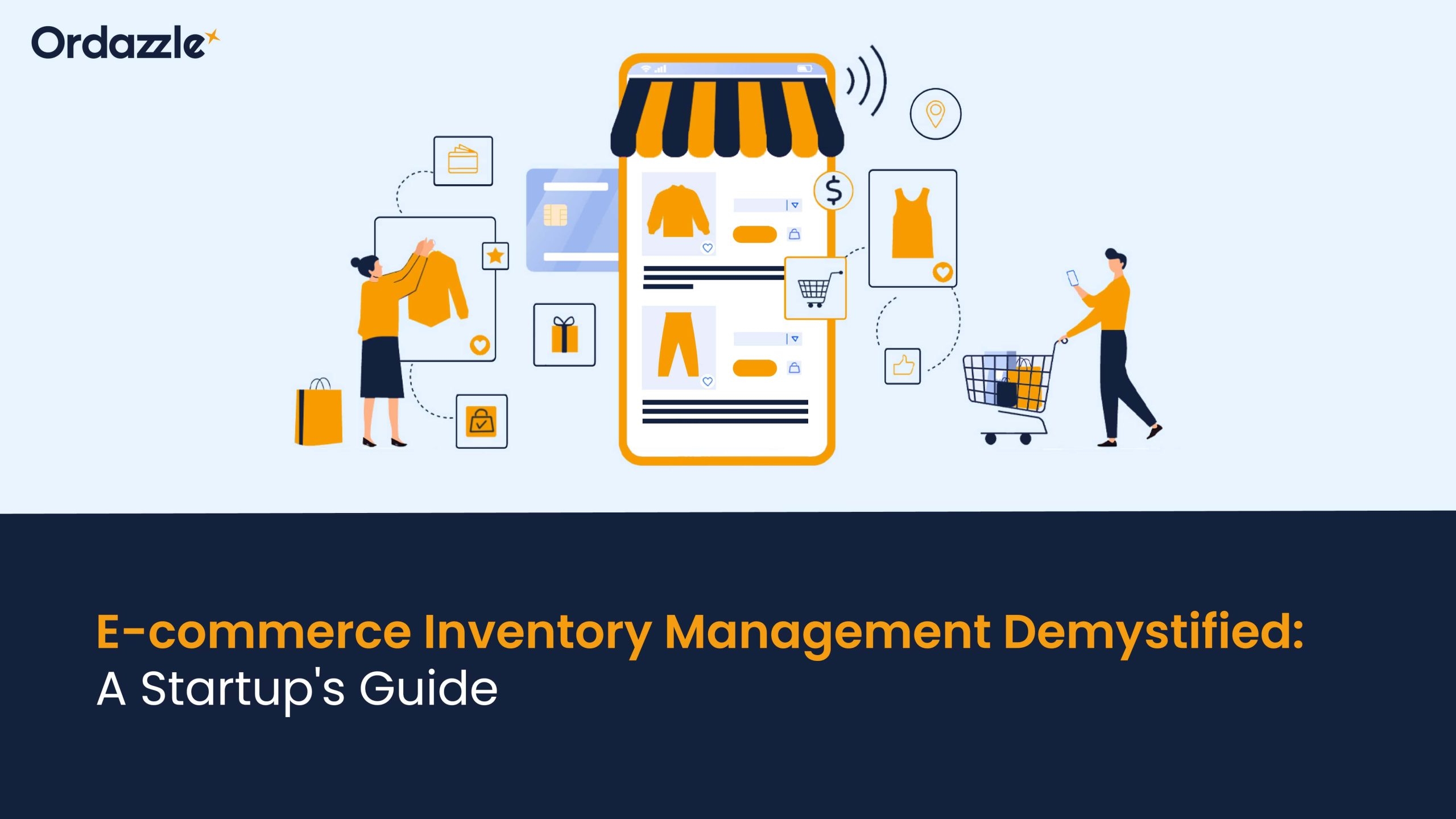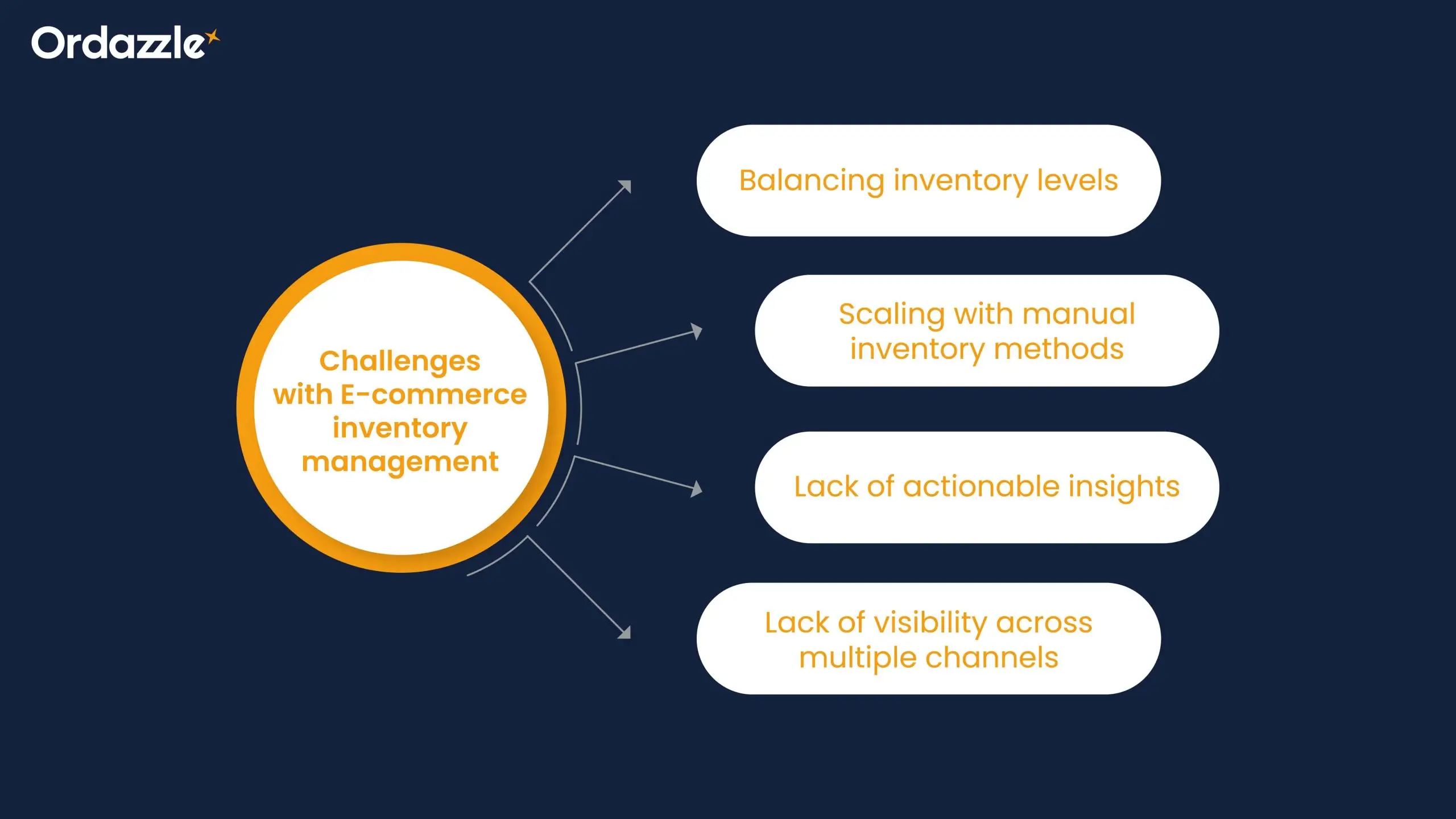E-commerce Inventory Management Demystified: A Startup’s Guide

In the digital age, where innovation reigns supreme and disruption is the norm, startups emerge as the ones who are fearless of charting new territories and dreaming big. But every dream needs a solid foundation, and for e-commerce ventures, that foundation is effective e-commerce inventory management.
Picture it as the fuel for your online store, powering your growth and propelling you toward success. As a startup aiming to build a sustainable, profitable, and scalable e-commerce venture, handling stock orders and order fulfillment can feel daunting. Yet, with an effective inventory system, tracking and managing your inventory becomes simpler.
In this blog, we will discuss the intricacies of building and managing e-commerce inventory, shed light on the challenges, and unveil strategies essential for your entrepreneurial journey.
So, what exactly is e-commerce Inventory Management?
Simply put, e-commerce inventory management is an organized approach to handling inventory in the world of online selling. It’s all about keeping your marketplace stocked and ready for business. This means handling everything from sourcing and storing products to selling, shipping, and tracking them in an organized way.
Essentially, it’s about staying in the know—keeping track of what’s ordered, what’s in storage, your sales stats, and which orders need your attention. By taking this proactive approach, you can avoid running out of stock and keep your customers coming back for more, building that all-important loyalty along the way.
Why Does E-commerce Inventory Management Matter for Startups?
Picture this: you’re running an online store, and suddenly, a surge of orders floods in. Without proper inventory management, you risk being unable to fulfill those orders, leaving customers disappointed. Efficient inventory management is the key to preventing such nightmares and ensuring smooth e-commerce operations.
At the core of any successful e-commerce venture lies effective inventory management, which brings a host of benefits:
- Improved Multi-channel Inventory Forecasting: With multiple offline and online channels, effective multi-channel inventory management ensures precise inventory forecasting. This optimizes storage levels and production flow across all channels, allowing timely adjustments to meet demand and align seamlessly with sales trends through regular inventory pattern analysis.
- Cost Optimisation: Bid farewell to excessive storage costs and revenue loss from stockouts. With efficient inventory management, startups can minimize waste and maximize profitability, redirecting savings to other aspects of their business operations.
- Customer Satisfaction: Customers expect nothing short of perfection. By maintaining optimal stock levels and promptly fulfilling orders, startups can nurture a loyal customer base and cultivate a stellar reputation.
- Theft and Fraud Management: No business likes losses, especially when they are from theft or fraud. Having an inventory system can help prevent these kinds of situations by tracking stock levels and locations and limiting access to trusted employees. By showing the staff you keep close track of everything, you can deter dishonest behavior.
Scalability and Growth: As startups expand, the intricacies of e-commerce inventory management become more complex. By implementing robust systems and processes early on, startups can future-proof their operations and lay the groundwork for sustainable growth.
Challenges with E-commerce Inventory Management

Navigating e-commerce inventory management comes with its fair share of challenges. Every online business owner encounters hurdles along the way, but it’s how they tackle them that sets them apart. Here are some common issues that can impact your startup’s growth, profit, and customer satisfaction:
Challenge #1: Balancing inventory levels
Overstocking and overselling are prevalent challenges in e-commerce management. Precise understanding of inventory and customer buying patterns is vital. Running low on inventory can lead to disappointed customers while having too many ties up valuable resources and risks damaging your reputation. Real-time tracking and clear availability indicators help keep things running smoothly.
Challenge #2: Scaling with manual inventory methods
When starting in e-commerce, manual inventory tracking might seem manageable, but as your business grows, it becomes a hindrance. Managing multiple partners, vendors, and warehouses becomes increasingly complex and prone to errors. Investing in flexible processes and tools ensures your business can adapt and grow seamlessly.
Challenge #3: Lack of actionable insights
Without access to detailed data analysis, it’s hard to anticipate changes in demand or optimize operations. Real-time inventory data is crucial for making informed decisions and seizing opportunities as they arise. Having a centralized system for gathering and analyzing data is key to overcoming this challenge.
Challenge #4: Lack of visibility across multiple channels
As your business expands and inventory management becomes more complex, it’s essential to have visibility across all channels. Without a clear view of your inventory management system, it’s difficult to know which decisions need to be made and by when they need to be made to continue boosting sales and meeting consumer demand.
By addressing these challenges head-on and implementing effective strategies, your startup can better manage your inventory with confidence and success.
What are some e-commerce Inventory Management Strategies?
When it comes to inventory management, the ‘one-size-fits-all’ theory may not work. Every business has unique needs that may require different tracking approaches. Let’s take a look at some strategies to find the right fit for your business:
ABC Analysis
This method categorizes inventory based on its importance and value. Class A items, the most critical and valuable, get close attention and tight control, while Class C items, less critical and lower in value, are managed more loosely. This strategy aids in efficiently prioritizing efforts and allocating resources according to the importance of inventory items within the industry.
Just-in-time Inventory Management
With JIT, businesses stock products only when a customer orders them, keeping inventory levels closely aligned with demand. This e-commerce inventory management approach aims to minimize inventory costs by synchronizing production with demand.
First In, First Out
In warehousing, FIFO (First In, First Out) dictates that the earliest received products are the first to be dispatched to consumers. This practice is particularly beneficial for retailers dealing with perishable goods as it ensures timely turnover while maintaining product freshness.
Safety Stock
Safety stock is a common inventory management strategy utilized by businesses to buffer against unexpected fluctuations in demand. Unlike Just-In-Time (JIT) methods, safety stock involves maintaining surplus inventory to address sudden spikes in demand or unforeseen delays in the supply chain. This ensures continuity of operations and minimizes the risk of stockouts during periods of increased demand or disruptions in supply.
Getting Started With Inventory Management
Now that you have grasped the basics and challenges of inventory management in e-commerce, it’s time for action. Follow these steps to build an optimized inventory management system for your online startup:
1.Understand product category demand
To kickstart effective e-commerce inventory management, particularly for a new online store, it is important to grasp the demand dynamics within your product category. Analyze how demand varies over time to ensure optimal stocking levels and anticipate customer preferences. Utilize Google Trends to examine search demand and interest in your category over the past year or longer. Identify popular products and anticipate demand fluctuations to stock up appropriately.
2. Forecast future demand
Step two in optimizing inventory management involves forecasting future demand, which includes predicting both regular and seasonal fluctuations in demand. Analyze past sales to forecast future demand, including seasonal peaks. Plan for major selling opportunities like holidays and events to prevent stock shortages. If sales history is lacking, refer to Google Trends and Analytics analysis.
3. Prioritize products with the right e-commerce inventory management strategy
To enhance efficiency and cost-effectiveness, prioritize products using an appropriate inventory management strategy. Utilize suitable strategies to determine which products require the most focus in terms of inventory management. The objective is to gain insight into which products demand greater attention and resources.
4. Setting minimum stock levels
If your e-commerce shop is already running, you should also take the time to set minimum viable stock levels for every product you sell at all your channels, ensuring effective multi-channel inventory management. Determine minimum viable stock levels for each product to meet demand and avoid fulfillment delays. Adjust these levels based on changing demand patterns over time.
5. Prepare for seasonality
If you’re running an e-commerce store, prepare inventory levels for seasonal peaks and shopping seasons. Promote special offers to sell excess inventory at the end of peak seasons to avoid dead stock. Utilize slower periods to optimize resources and prepare for future sales periods.
6. Consider inventory management tools
Explore inventory management systems with automation features to streamline processes and reduce errors. Utilize inventory tracking to monitor warehouse inventory flows and anticipate customer demand. Integrate inventory management software with your e-commerce platform for efficient order fulfillment and enhanced customer satisfaction.
With the many challenges that come with the supply chain, your approach to overcoming them can make or break your business in such crucial times. Many successful e-commerce businesses are turning to other logistics partners to navigate the supply chain crisis.
In this shift, Ordazzle, a leading e-commerce solution provider, leads the way. Our logistics management system and software solutions, supported by a proven track record, make us the perfect partner for companies striving in the supply chain. With our integrated systems, businesses can easily manage all logistics providers and track multiple orders across various marketplaces and carriers simultaneously.
Contact us to learn more about our logistics solutions and see how we can help your business adapt and succeed with ease.
Empower Your Startup with Ordazzle
Your inventory is the cornerstone of your success in e-commerce. Effective inventory management is essential for a thriving online business, helping you make informed purchasing decisions and gaining valuable insights into your warehouse inventory. Without a reliable inventory management system, achieving these goals can be incredibly challenging.
Enter Ordazzle, your premier partner in e-commerce management solutions. We are dedicated to streamlining your inventory processes with our cutting-edge multi-channel inventory management system. With real-time monitoring, control, and optimization across all channels, our system ensures seamless integration with marketplaces, reducing revenue losses by providing a unified view of your inventory.
Connect with our experts today to elevate your inventory operations to unparalleled heights.


